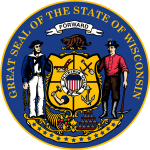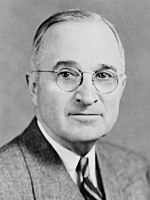| ||||||||||||||||||||||||||
| ||||||||||||||||||||||||||
 County Results
| ||||||||||||||||||||||||||
| ||||||||||||||||||||||||||
| Elections in Wisconsin |
|---|
 |
The 1948 United States presidential election in Wisconsin was held on November 2, 1948, as part of the 1948 United States presidential election. State voters chose 12 electors to the Electoral College, who voted for president and vice president.
Politics in Wisconsin since the Populist movement had been dominated by the Republican Party.[1] The Democratic Party became uncompetitive outside certain eastern German areas as the upper classes, along with the majority of workers who followed them, fled from William Jennings Bryan’s agrarian and free silver sympathies.[2] Although the state did develop a strong Socialist Party to provide opposition to the GOP, Wisconsin developed the direct Republican primary in 1903 and this ultimately created competition between the “League” under Robert M. La Follette, and the conservative “Regular” faction.[3] This ultimately would develop into the Wisconsin Progressive Party in the late 1930s, which was opposed to the conservative German Democrats and to the national Republican Party, and allied with Franklin D. Roosevelt at the federal level.
During the two wartime elections, the formerly Democratic German counties in the east of the state – which had been powerfully opposed to the Civil War because they saw it as a “Yankee” war and opposed the military draft instituted during it[4] – viewed Communism as a much greater threat to America than Nazism and consequently opposed President Roosevelt's war effort.[5] Consequently, these historically Democratic counties became virtually the most Republican in the entire state, and the two wartime elections were very close after Roosevelt had in 1932 and 1936, aided by the support of Robert M. La Follette Jr., carried Wisconsin by more than two-to-one.
As the Progressive Party disintegrated and its members returned to the GOP, that party regained its hegemony in the state legislature and Congressional representation, so that by 1946 Wisconsin had an entirely Republican Congressional delegation for the first time since the 71st Congress, and the Democrats’ representation in the state legislature fell as low as it had been since that same point.
Although the state's Republican presidential primary went to Harold E. Stassen of neighboring Minnesota, the earliest polls had second-time nominee Thomas E. Dewey well ahead of incumbent Harry S. Truman.[6] A final poll on the first day of November had Dewey leading by 56 percent to 41 percent, with “People’s Progressive” nominee and former Vice-president Henry A. Wallace on three percent.[7]
Nonetheless, as he achieved elsewhere in the Midwest, Truman made a major comeback to claim Wisconsin by a larger margin than Roosevelt had done in 1940. His victory was attributed to the fact that Dewey, compared to 1944, soft-pedalled the issue of communism,[8] to the fact that a large number of isolationist voters who had been responsible for the dramatic Republican presidential gains earlier in the decade stayed home, and to fear of loss of New Deal farm programs if Dewey were elected.[9] Henry Wallace's candidacy, of which much had been expected due to the state's isolationism, disappointed, receiving only 1.98 percent of the vote mostly from historically progressive Scandinavian-Americans,[10] further helping Truman.
- ^ Burnham, Walter Dean; 'The System of 1896: An Analysis'; in The Evolution of American Electoral Systems, pp. 178-179 ISBN 0313213798
- ^ Sundquist, James; Politics and Policy: The Eisenhower, Kennedy, and Johnson Years, p. 526 ISBN 0815719094
- ^ Hansen, John Mark; Shigeo Hirano, and Snyder, James M. Jr.; ‘Parties within Parties: Parties, Factions, and Coordinated Politics, 1900-1980’; in Gerber, Alan S. and Schickler, Eric; Governing in a Polarized Age: Elections, Parties, and Political Representation in America, pp. 165-168 ISBN 978-1-107-09509-0
- ^ Phillips, Kevin P.; The Emerging Republican Majority, pp. 381-382, 414 ISBN 978-0-691-16324-6
- ^ Phillips; The Emerging Republican Majority, pp. 387-388
- ^ Gallup, George; ‘Dewey Barely Won Wisconsin In '44; It's in the Bag Today: Dewey to Fore In Wisconsin’; The Washington Post, September 25, 1948, p. 1
- ^ Gallup, George; ‘Final Poll Gives Dewey 49.5%, Truman 44.5% of Popular Vote’; The Washington Post, November 1, 1948, p. 1
- ^ Fried, Richard M.; ‘“Operation Polecat”: Thomas E. Dewey, the 1948 Election, and the Origins of McCarthyism’; Journal of Policy History, Vol. 22, Issue 1, (January 2010), pp. 1-22
- ^ Phillips; The Emerging Republican Majority, p. 431
- ^ Phillips; The Emerging Republican Majority, p. 433


